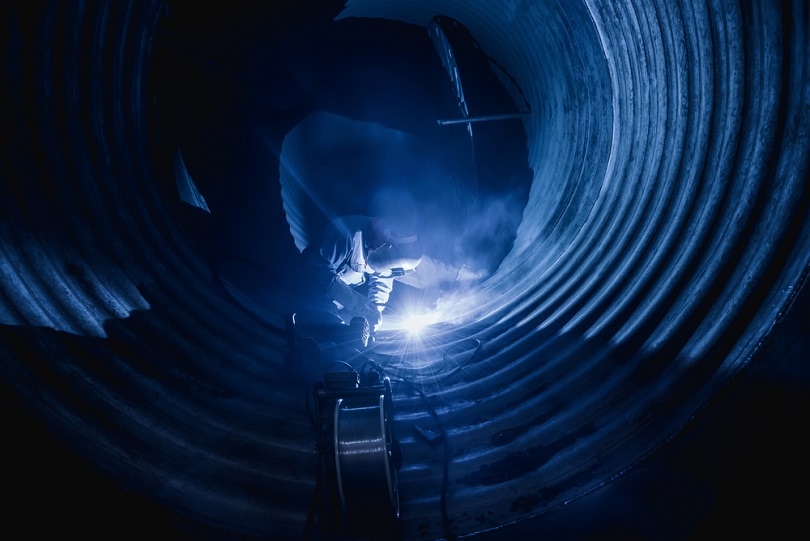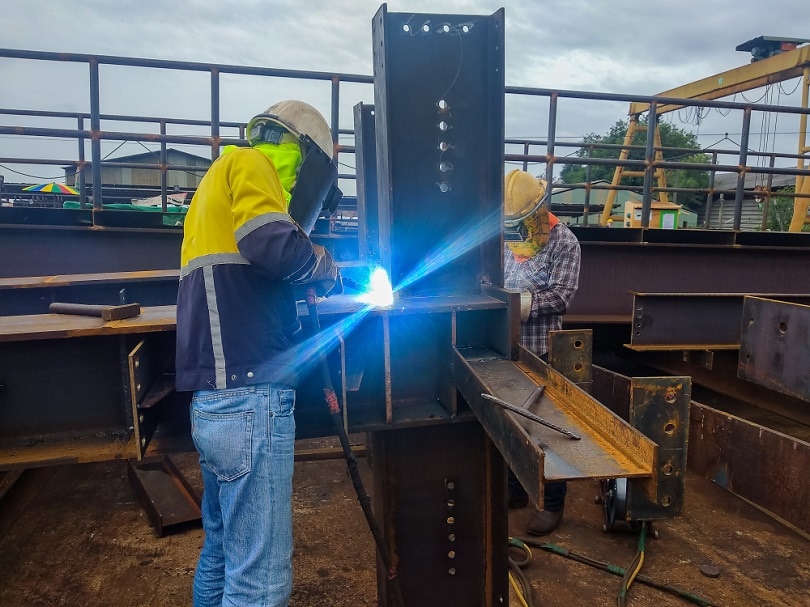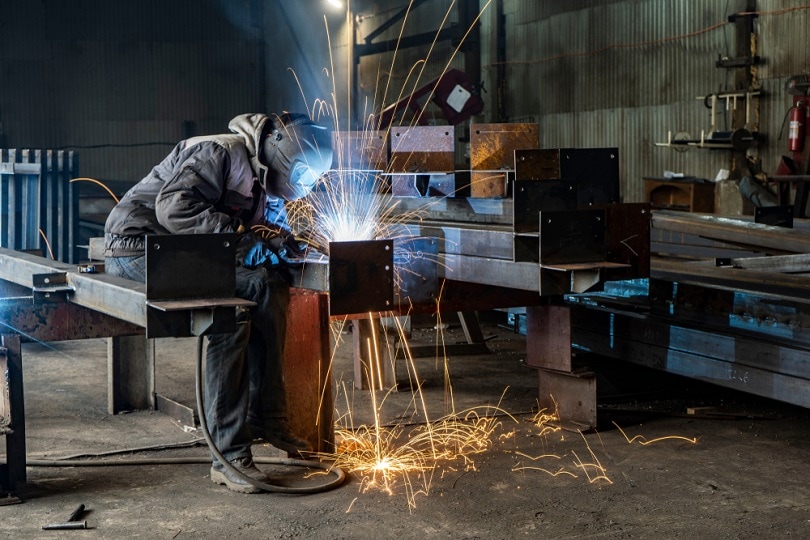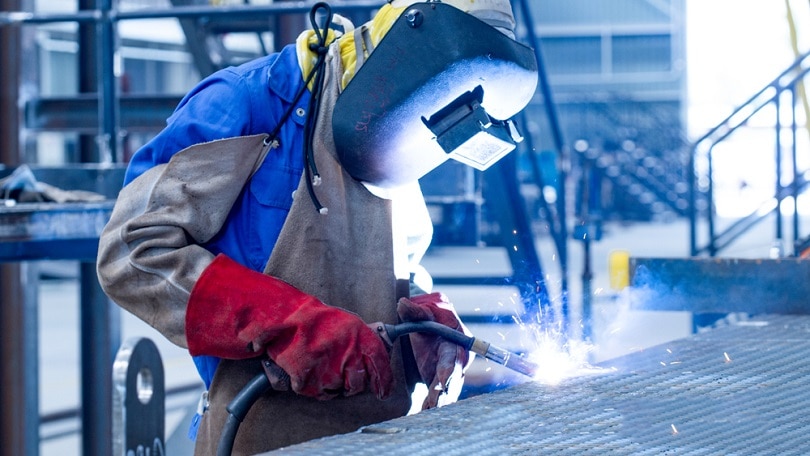How Do You Know What Voltage Setting for an Fcaw Weld
0
What is Flux-Cored Arc Welding? Understanding information technology Thoroughly
Terminal Updated on

When it comes to structural steel fabrication, few welding processes are more efficient than Flux-cored Arc Welding (FCAW). Using the aforementioned essential equipment as Metal Inert Gas Welding (MIG or GMAW), Flux-cored Arc welding deposits filler metal using a flux-cored wire. The result is a deposition rate that is virtually ten times college than Shielded Metal Arc Welding (SMAW or Stick). Developed in the early 1950s, Flux-cored welding has increased efficiency in production environments.
How Does Flux-Cored Arc Welding Piece of work?
Flux-cored welding uses the aforementioned equipment as MIG welding. This includes welder/inverter, wire feeder, semi-automated welding gun, and basis clench. Since the power source is based on CV (abiding voltage) which can be adjusted, this means that the arc length will stay constant throughout welding. The overall current tin be inverse past increasing or decreasing the wire-feed speed (WFS).

Credit: Thaweesak Thipphamon, Shutterstock
But Flux-cored welding differs from MIG welding in that information technology uses a different type of wire. MIG welding is virtually often chosen 'hard-wire.' While Flux-cored isn't exactly 'soft-wire,' it is brittle past hand (most fabricators exercise not clip off their flux-cored wire with welding pliers). It is not solid all the way through. Instead, the tubular wire contains a flux on the inside. When the wire burns during welding, the burning flux is deposited into the weld pool likewise.
The fabric from the flux rises to the top of the molten weld puddle and creates a sort of temporary 'casing' to protect the weld while it cools. And since the flux rises to the top, when welded properly, it is not embedded in the weld itself. The resulting slag, as it is chosen, can then be chipped off with a slag hammer or a needle gun, leaving you with a structurally sound weld.
What Are the Different Types of Flux-Cored Arc Welding?
- Dual Shield
Also chosen FCAW-G, the 'G' denoting that it is to be used with shielding gas. The all-time polarity to be used with Dual Shield is DCEP (Directly Current Electrode Positive). This essentially means that about ⅔ of the heat from the arc volition be focused on melting the electrode wire, while ⅓ of the heat will exist focused on the workpiece. FCAW-G is called Dual Shield welding because it has two complementary ways that the weld is 'shielded' during welding.
The flux burns and creates a protective slag. At the aforementioned time, the shielding gas which is emitted from the gas diffuser on the welding gun helps protect the weld from outside contaminants such as oxygen. But an important thing to call up with Dual Shield FCAW is that though there are 2 methods of shielding the weld, both are required since the wire is designed to be used with shielding gas. If you run out of gas in the heart of welding, you lot tin look to come across pinholes and slag inclusions in your weld! The two about mutual shielding gases that are used for Dual Shield are 100% carbon dioxide or less common, a mix of 75% carbon dioxide and 25% argon. The reason the mix is less mutual is that it is more expensive.
- Cocky-Shielded (Innershield)
Innershield is Lincoln Electrical's brand proper name for what we know as self-shielded FCAW (FCAW-Southward). It uses DCEN (Directly Electric current Electrode Negative) as its polarity. This means that about ⅔ of the heat from the arc is concentrated on the workpiece while ⅓ of the heat is burning the electrode. Unlike Dual Shield, the wire for Self-Shielded FCAW does non crave a shielding gas. Information technology is intended to be used without shielding gas. Betwixt these two wires, this is the preferred method for those who work outdoors. Ironworkers and people who exercise a lot of mobile welding repairs tend to adopt Self-Shielded.
- Other Variables
These two wires that are listed are simply the two largest categories for Flux-Cored welding wire. The almost common FCAW wires are geared toward welding mild steel. Just others are loftier in nickel and are designed for welding special alloys. All of these wires come in a variety of sizes equally well. In a fabrication setting, the choice will usually depend upon the WPS (Welding Procedure Specification). Wire bore can affect the deposition rate and depending on the setting of the machine, tin can brand or break the proper weld size.

Credit: Suvorov_Alex, Shutterstock
Where is it Used?
- Dual Shield
Dual Shield welding is most ofttimes used in fabrication shops, peculiarly those that bargain with structural steel. Since it has such a high deposition rate and effective weld penetration, it has all only completely replaced Stick welding in a fabrication setting. FCAW for fabrication is i of the easier processes to learn. Most of the welding can be washed in the horizontal or flat position. When the welds required are out of position, unless the workpiece is massive, it tin be rotated to facilitate welding in the flat or horizontal position.
- Cocky-Shielded
Innershield is the preferred option for welding exterior. This makes information technology the favorite for those exposed to the weather condition. Since it is designed to exist used without shielding gas, it can be used in high winds. Often in a construction setting like the erection of a skyscraper or other alpine office edifice, Self-Shielded welding will be used in conjunction with Stick welding. This is because Cocky-Shielding welding uses more equipment. If the piece of work is to be done upwards high, though the deposition rate is much lower, information technology is oftentimes easier to throw a small Arc welder in the scissor lift. Carrying the MIG equipment can be a hassle in certain situations since it'due south a more complicated setup.
- Encounter likewise: How Hot is a Welding Arc?
Advantages of Flux-Cored Arc Welding
- Efficiency
FCAW is 1 of the most efficient welding processes out at that place. It'south used by fabricators and construction workers akin. The principal reason that it is used and so widely is its efficiency. The deposition charge per unit can be x times higher than Stick welding. Since the filler metal runs off of a wire-feeder, this also means that you lot will not have to make every bit many stops and starts. With SMAW, fourteen-inch rod electrodes will not get yous as many passes as FCAW.
- Facility
Depending upon the awarding, this is i of the easiest welding processes to learn. While no welding process is easy to learn, welding instructors ofttimes recommend that their students get their certification in FCAW-K since it is one of the easier tests to pass and it opens upward more job opportunities. FCAW uses a welding gun equally used in standard MIG welding. The arc is relatively stable due to the CV current. The welding gun is easier to control than a 14-inch electrode hanging out of a stinger (Stick electrode holder).
Disadvantages of Flux-Cored Arc Welding
- Environment Specific
While it is true that FCAW can exist used outside with Self-Shielded, and indoors with Dual-Shield, at that place are cases where this rule does not apply. The carbon-dioxide or other shielding gas can exist blown away even from a mild cakewalk blowing into the shop or piece of work area. This can exist remedied in a variety of ways.
Even though Self-Shielded tin be used outdoors, fifty-fifty in inclement conditions, it is not a safeguard against h2o. A trivial wet near the weld zone is not going to hurt, but it'south non recommended that you weld over a puddle of water either.
- Defects
Okay, then defects are a problem in all welding processes. They are almost exclusively due to user error. Simply in that location is an boosted downside to flux-cored arc welding defects. If you weld fast, y'all make mistakes equally fast. At that place's goose egg worse than laying a root laissez passer in overhead for a groove weld but to notice out that it was full of porosity because you ran out of gas. This means yous will have to grind, or carbon-arc gouge the weld out and starting time over. Not fun to exercise if you're working overhead! Common defects with FCAW are undercut (where the base metallic is penetrated but not filled in) slag inclusions (pockets of flux stuck in the weld), porosity (pinholes in the weld appearance), and lack of fusion.

Credit: YAKISTUDIO, Shutterstock
Ofttimes Asked Questions (FAQs)
Can You Weld Flux-Cored Outdoors?
We discussed that self-shielded FCAW is the preferred choice for welding outdoors since it is designed for being exposed to the weather. Even so, there are situations where y'all either don't accept the proper self-shielded wire, or you are not certified to weld cocky-shielded FCAW. The arc characteristics of Dual Shield are much smoother and preferable besides. Then, the question is, "If the wind and light breezes can blow abroad the gas, how can I weld Dual Shield outdoors?" At that place are a few things you can do.
Start, is to plough upward your shielding gas to a higher CFH (cubic anxiety per hour). This will provide you with more gas coverage to counteract the current of air. Secondly, utilize welding screens, fire blankets, paper-thin, or any sort of barrier that y'all tin can find to simulate welding 'indoors,' outdoors. Do note that turning your shielding gas upwardly too high on the regulator attached to the gas cylinder, can cause strain and damage over time to the regulator.
Why is CO2 Preferred as a Shielding Gas for FCAW?
The reasons for this are 2-fold. The first is that it is less expensive than the 75/25 Argon-CO2 mix. Flux-Cored welding when used with CO2 tends to also dig more than into the metal. This can be frustrating especially when you have to clean out the divots made before welding again. Some students who are trained using 75/25 mix come to a rude enkindling when they have to weld with 100% carbon dioxide for this reason. Even though this might seem like a drawback, it provides improve articulation penetration when welded properly.
Is a Flux-Cored Welding Machine Good for Home Employ?
That all depends on the type of work that you will be doing. The welds that FCAW produces are potent but not necessarily aesthetically pleasing. If you take to repair a trailer it can be a skilful option. Simply it'due south probably not the all-time for an art project. Standard MIG difficult wire tin can produce cleaner-looking welds if you need it to await pretty.
Conclusion
In that location is no other welding process that is as versatile as it is productive in different climates. Information technology has improved several different industries due to its efficiency, teachability, and availability. What started every bit an culling to Stick welding nearly 75 years ago has taken the fabrication and construction industry by storm.
Featured image credit: N_Sakarin, Shutterstock
- How Does Flux-Cored Arc Welding Piece of work?
- What Are the Different Types of Flux-Cored Arc Welding?
- Advantages of Flux-Cored Arc Welding
- Disadvantages of Flux-Cored Arc Welding
- Often Asked Questions (FAQs)
- Can You Weld Flux-Cored Outdoors?
- Why is CO2 Preferred equally a Shielding Gas for FCAW?
- Is a Flux-Cored Welding Machine Good for Home Use?
- Decision
Cameron Dekker
Cameron grew up in Allentown, Pennsylvania, a once-proud steel town on the Lehigh River, where he got a taste of TIG welding in his high schoolhouse shop grade. He holds certificates for Certified WeldingEducator (CWE) and Certified Resistance Welding Technician (CRWT) from the American Welding Constitute. His interests include scuba diving, sculpture, and kayaking.
Source: https://waterwelders.com/what-is-flux-cored-arc-welding/
0 Response to "How Do You Know What Voltage Setting for an Fcaw Weld"
Post a Comment